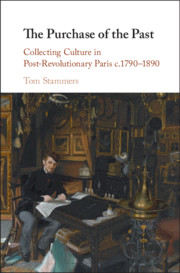Book contents
- The Purchase of the Past
- The Purchase of the Past
- Copyright page
- Epigraph
- Contents
- Illustrations
- Acknowledgements
- Introduction
- 1 Amateurs and the Art Market in Transition (c.1780–1830)
- 2 Archiving and Envisioning the French Revolution (c.1780–1830)
- 3 Book Hunting, Bibliophilia and a Textual Restoration (c.1790–1840)
- 4 Salvaging the Gothic in Private and Public Spaces (c.1820–1870)
- 5 Royalists versus Vandals, and the Cult of the Old Regime (c.1860–1880)
- 6 Allies of the Republic?
- Conclusion
- Bibliography
- Index
4 - Salvaging the Gothic in Private and Public Spaces (c.1820–1870)
Published online by Cambridge University Press: 01 June 2020
- The Purchase of the Past
- The Purchase of the Past
- Copyright page
- Epigraph
- Contents
- Illustrations
- Acknowledgements
- Introduction
- 1 Amateurs and the Art Market in Transition (c.1780–1830)
- 2 Archiving and Envisioning the French Revolution (c.1780–1830)
- 3 Book Hunting, Bibliophilia and a Textual Restoration (c.1790–1840)
- 4 Salvaging the Gothic in Private and Public Spaces (c.1820–1870)
- 5 Royalists versus Vandals, and the Cult of the Old Regime (c.1860–1880)
- 6 Allies of the Republic?
- Conclusion
- Bibliography
- Index
Summary
This chapter examines the career of Alexandre-Charles Sauvageot, the violinist-turned-collector of French medieval and Renaissance art, who became one of the prime donors to the Louvre in the nineteenth century. It reconstructs his social networks of collectors in the immediate post-revolutionary period and examines how their purchases were identified as a salvage crusade. It points out the ambivalence of Sauvageot’s cabinet as both a domestic space and a semi-public urban attraction and explores the mixed motives that prompted his unprecedented decision to donate his artworks to the Louvre in 1856. To that extent, it explores not only why the Second Empire witnessed a growing convergence between private collectors and state cultural institutions, but also the ongoing tensions created by this new partnership. It traces the fate of Sauvageot’s bequest after his death and suggests why the reputation of his collection was soon overtaken by other developments in the 1860s in the taste for the fine and decorative arts.
Keywords
- Type
- Chapter
- Information
- The Purchase of the PastCollecting Culture in Post-Revolutionary Paris c.1790–1890, pp. 159 - 202Publisher: Cambridge University PressPrint publication year: 2020

